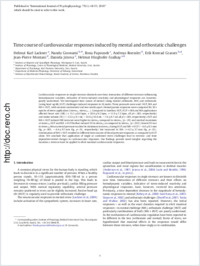Time course of cardiovascular responses induced by mental and orthostatic challenges
- Lackner, Helmut Karl Institute of Adaptive and Spaceflight Physiology, Graz, Austria
- Goswami, Nandu Institute of Physiology, Center of Physiological Medicine, Medical University, Graz, Austria
- Papousek, Ilona Department of Psychology, Karl Franzens University, Graz, Austria
- Roessler, Andreas Institute of Physiology, Center of Physiological Medicine, Medical University, Graz, Austria
- Grasser, Erik Konrad Institute of Physiology, Center of Physiological Medicine, Medical University, Graz, Austria - Department of Medicine/Physiology, University of Fribourg, Switzerland
- Montani, Jean-Pierre Department of Medicine/Physiology, University of Fribourg, Switzerland
- Jezova, Daniela Institute of Experimental Endocrinology, Slovak Academy of Science, Bratislava, Slovakia
- Hinghofer-Szalkay, Helmut Institute of Adaptive and Spaceflight Physiology, Graz, Austria
-
29.11.2009
Published in:
- International Journal of Psychophysiology. - 2010, vol. 75, no. 1, p. 48-53
Mental arithmetic
Head up tilt
Cardiovascular reactivity
Time course
Habituation
Blood pressure
Heart rate
English
Cardiovascular responses to single stressors diminish over time. Interaction of different stressors influencing hemodynamic variables, indicative of stress-induced reactivity and physiological responses are, however, poorly understood. We investigated time course of mental (using mental arithmetic, MA) and orthostatic (using head up tilt, HUT) challenges induced responses in 16 males. Three protocols were used: HUT, MA and MA + HUT, with sessions randomized and two weeks apart. Hemodynamic responses were compared for 30 s epochs of stress application (stressT1, stressT2…). Compared to baseline, HUT, HUT + MA and MA applications affected heart rate (HR) (+ 15.1 ± 8.0 bpm, + 20.0 ± 9.2 bpm, + 11.9 ± 7.2 bpm, all p's < .001, respectively) and stroke volume (SV) (− 22.3 ± 8.1 ml, − 22.0 ± 10.4 ml, − 7.6 ± 8.7 ml, all p's < .001, respectively). HUT and MA + HUT induced HR increases were higher in stressT2 compared to stressT1 (p < .05) and reached maximum at stressT2. HUT and MA + HUT further reduced SV in stressT2 as compared to stressT1 (p < .001); lowest SV was in stressT2. Mean arterial pressure reached its minimum in stressT1 during HUT and MA + HUT (− 6.0 ± 8.5 mm Hg, p < .001, − 4.4 ± 9.7 mm Hg, p < .01, respectively) but increased in MA (+ 4.3 ± 3.7 mm Hg, p < .01). Combination of MA + HUT resulted in different time courses of blood pressure responses as compared to HUT alone. We conclude that application of single or combined stress challenges lead to stressor- and time dependent-initial changes in cardiovascular responses. Our findings provide novel insights regarding the duration a stressor must be applied to elicit maximal cardiovascular responses.
- Faculty
- Faculté des sciences et de médecine
- Department
- Département de Médecine
- Language
-
- English
- Classification
- Biological sciences
- License
-
License undefined
- Identifiers
-
- RERO DOC 17293
- DOI 10.1016/j.ijpsycho.2009.11.003
- Persistent URL
- https://folia.unifr.ch/unifr/documents/301217
Statistics
Document views: 125
File downloads:
- pdf: 264
